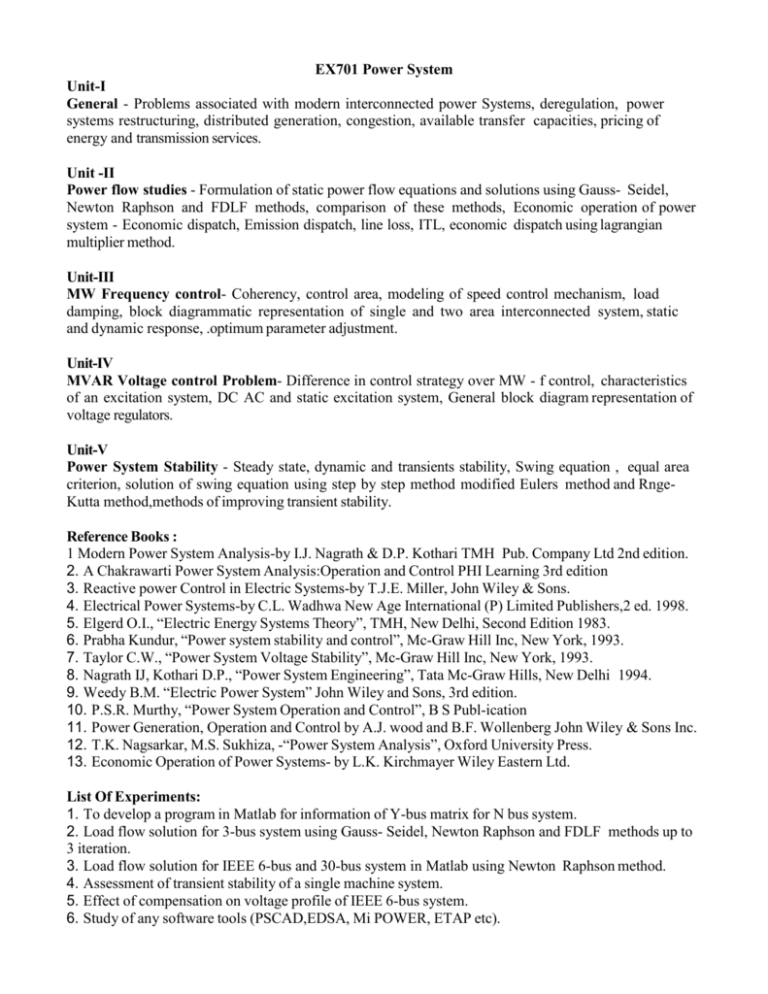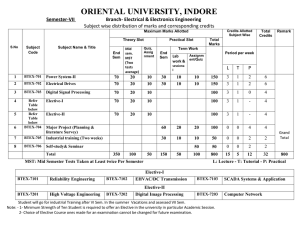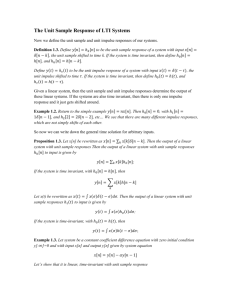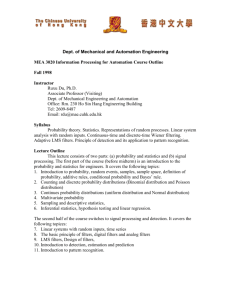Unit-V
advertisement

EX701 Power System Unit-I General - Problems associated with modern interconnected power Systems, deregulation, power systems restructuring, distributed generation, congestion, available transfer capacities, pricing of energy and transmission services. Unit -II Power flow studies - Formulation of static power flow equations and solutions using Gauss- Seidel, Newton Raphson and FDLF methods, comparison of these methods, Economic operation of power system - Economic dispatch, Emission dispatch, line loss, ITL, economic dispatch using lagrangian multiplier method. Unit-III MW Frequency control- Coherency, control area, modeling of speed control mechanism, load damping, block diagrammatic representation of single and two area interconnected system, static and dynamic response, .optimum parameter adjustment. Unit-IV MVAR Voltage control Problem- Difference in control strategy over MW - f control, characteristics of an excitation system, DC AC and static excitation system, General block diagram representation of voltage regulators. Unit-V Power System Stability - Steady state, dynamic and transients stability, Swing equation , equal area criterion, solution of swing equation using step by step method modified Eulers method and RngeKutta method,methods of improving transient stability. Reference Books : 1 Modern Power System Analysis-by I.J. Nagrath & D.P. Kothari TMH Pub. Company Ltd 2nd edition. 2. A Chakrawarti Power System Analysis:Operation and Control PHI Learning 3rd edition 3. Reactive power Control in Electric Systems-by T.J.E. Miller, John Wiley & Sons. 4. Electrical Power Systems-by C.L. Wadhwa New Age International (P) Limited Publishers,2 ed. 1998. 5. Elgerd O.I., “Electric Energy Systems Theory”, TMH, New Delhi, Second Edition 1983. 6. Prabha Kundur, “Power system stability and control”, Mc-Graw Hill Inc, New York, 1993. 7. Taylor C.W., “Power System Voltage Stability”, Mc-Graw Hill Inc, New York, 1993. 8. Nagrath IJ, Kothari D.P., “Power System Engineering”, Tata Mc-Graw Hills, New Delhi 1994. 9. Weedy B.M. “Electric Power System” John Wiley and Sons, 3rd edition. 10. P.S.R. Murthy, “Power System Operation and Control”, B S Publ-ication 11. Power Generation, Operation and Control by A.J. wood and B.F. Wollenberg John Wiley & Sons Inc. 12. T.K. Nagsarkar, M.S. Sukhiza, -“Power System Analysis”, Oxford University Press. 13. Economic Operation of Power Systems- by L.K. Kirchmayer Wiley Eastern Ltd. List Of Experiments: 1. To develop a program in Matlab for information of Y-bus matrix for N bus system. 2. Load flow solution for 3-bus system using Gauss- Seidel, Newton Raphson and FDLF methods up to 3 iteration. 3. Load flow solution for IEEE 6-bus and 30-bus system in Matlab using Newton Raphson method. 4. Assessment of transient stability of a single machine system. 5. Effect of compensation on voltage profile of IEEE 6-bus system. 6. Study of any software tools (PSCAD,EDSA, Mi POWER, ETAP etc). EX702 Electrical Drives Unit - I Control of D.C. motors by converters:- Introduction to Thyristor Controlled Drives, single phase semi and fully controlled converters and three semi and fully controlled converters connected to d.c. separately excited and d.c. series motors-continuous current operation, Output voltage and current waveforms, Speed and Torque expression, Speed-Torque Characteristics, Problems on converter fed d.c. motors. Unit - II Four quadrant operation of D.C. Drives.:Introduction to Four quadrant operation, Motoring operations, Electric braking, Plugging, dynamic and regenerative braking operations. Four quadrant operation of D.C. motor by Dual converters-Closed loop operation of DC motor (Block diagram only)Control of D.C. Motors by Choppers:-Single quadrant, Two-quadrant and four quadrant chopper fed d.c. separately excited and series excited motors, Continuous current operation, Output voltage and current waveforms-Speed torques expressions-Speed torque characteristics, Problems on Chopper fed d.c. motors, Closed loop operation (Block diagram only) Unit-III Control of Induction Motors on stator side:-Control of Induction Motor by AC Voltage controllers- Waveforms, Speed torque characteristics, Variable frequency control of induction motor by Voltage Source,Current Source inverters and cycloconverters, PWM control Comparison of VSI & CSI operations, Speed- torque Characteristics, Numerical problems on induction motor drives, Closed loop operation of induction motor drives. (Block diagram only) Unit-IV Control of Induction Motors from rotor side:-Static rotor resistance control, Slip power recovery static Scherbius Drive, Static Kramer Drive, Their performance and speed torque characteristics advantages- application-problems. Unit-V Control of Synchronous Motors:- Separate control & Self control of synchronous motors, Operation of self controlled synchronous motors by VSI, CSI and Cycloconverters. Load commutated CSI fed Synchronous motor, Operation, Waveform, Speed torque Characteristics, Application, Advantage, Numerical problems, Closed loop operation os synchronous motors drives. (Block diagram only) References: 1. G.K. Dubey "Fundamentals of Electrical Drives"-. Narosa Publications 2. Gopal K. Dubey "Power semiconductor Controlled Drives"- PHI 3. S.B. Dewan, G.R. Slemon, A. Straughen "Power semiconductor Controlled Drives 4. B.K. Bose "Power Electronic control of AC Drives". PHI Learning. 5. Ned Mohan Electrical Drive Wiley India 6. V. Subramanyam "Thyristor control of Electric Drive" Tata Mc Graw Hill Pub 7. N.K. De , P.K. Sen "Electric Drives" PHI 8. S.K. Pillai, "A first course of Electrical Drive" New age International. 9. S.K. Pillai. "Analysis of Thyristor Power conditioned Motors" University Press (India)Ltd. 10. Longman P.V. Rao, "Power semiconductor Drives", BS Publications. 11. S.Shiva Nagaraju power semiconductor drive PHI learning EX703 Digital Signal Processing Unit- I Introduction to Digital Signal Processing, Discrete time signals & systems, linear shift invariant systems, stability and causality, Linear-constant coefficient difference equations, Frequency domain representation of discrete time signals and systems, properties of the Discrete Time Fourier transform (DTFT), Sampling and discrete time processing of continuous-time signals. Unit- II Applications of z-transforms, solution of difference equations of digital filters, System function, stability criterion, frequency response of stable systems, one sided Z-transform and its applications. Unit- III Discrete Fourier series: Properties of discrete Fourier series, DFS representation of periodic sequences. Discrete Fourier Transforms: Properties of DFT: Fast Fourier Transforms (FFT) - Radix-2 decimation in time and decimation in frequency FFT Algorithms. Inverse FFT. Unit- IV IIR DIGITAL FILTERS: Analog filter approximations - Butterworth and Chebyshev, Design of IIR Digital filters from analog filters, Bilinear transformation method, step & impulse invariance techniques, Spectral Transformations, Realization of IIR digital filters - direct, canonic, cascade & parallel forms. Unit- V FIR DIGITAL FILTERS: Characteristics of FIR Digital Filters frequency response, Design of FIR Digital Filters using Window Techniques. Comparison of IIR and FIR filters, Realization of FIR digital filters - direct, linear phase, cascade & parallel forms. References: 1. Oppenheim & Schaffer, Digital Signal Processing, PHI. 2. J Cavacchi Digital Signal Processing Wiley India 3. John G. Proakis Digital Signal Processing: Principles, Algorithms, And Applications, 4/E 4. Ludeman Fundamental of Digital Signal Processing, wiley india 5. A. Antoniou, Digital Filters Analysis & Design, TMH 6. A. Anand Kumar Digital Signal Processing ,PHI 7. S.K. Mitra, Digital Signal Processing, TMH Elective-I (EX-7101 – Reliability Engineering) UNIT-1 Introduction to reliability and indices. Review of probality theory. Density and distribution function of continuous and discrete random variable. UNIT-II Component reliability, hazard function, failure laws, exponential failure law, wear in period and its importance. Safety and reliability, replacement, methods of reliability improvement. UNITE-III Reliability evaluation of series, parallel, and series–parallel network. Complex network reliability evaluation using event, space, decomposition, tie-set, cut-set and, Satand by system and load sharing system,multi state models. UNIT-IV Markov process, State diagram, Availability and unavailability function. Evaluation of time dependent and limiting state probabilities. MTTF calculation. Concept of frequency and durations. State enumeration method for evaluating failure frequency, MUT, MDT,frequency balance approach. UNIT-V Reliability testing, estimation of reliability function, failure function and MTTF from grouped and ungrouped datas , censoring and accelerations ,parametric methods. TEXT BOOKS 1 Introduction to reliability engineering –E.E.Lewis, John Wiely and Sons, 1987 2 Reliability and maintainability engineering, C.E. Ebeling, TMH, 2006 Reference books 1Reliability Engineering : Probability Models and maintanance methods –Joel A.Nochlas,Taylor and Prancis 2005 2 Reliability evaluation of engineering system: concept and techniques-R. Billinton, R.N.Allon, Pitman, 1984 Elective-I (EX-7102 – EHV A.C. and D.C. Transmission) Unit- I Constitution of EHV a.c. and d.c. links, Kind of d.c. links, Limitations and Advantages of a.c. and d.c. transmission, Principal application of a.c. and d.c. transmission, Trends in EHV a.c. and d.c. transmission, Power handling capacity. Converter analysis garetz circuit, Firing angle control, Overlapping. Unit- II FACTS devices, basic types of controller, series controller, static synchronous series compensator (SSSC), thyristor-controlled series capacitor(TCSC), thyristor controlled series reactor(TCSR), shunt controller (STATCOM), static VAR compensator(SVC), series- series controller, combined seriesshunt controller, unified power flow controller (UPFC), thyristor controlled phase shifting transformer(TCPST). Unit- III Components of EHV d.c. system, converter circuits, rectifier and inverter valves, Reactive power requirements, harmonics generation, Adverse effects, Classification, Remedial measures to suppress, filters, Ground return. Converter faults & protection harmonics misoperation, Commutation failure, Multiterminal D.C. lines. Unit- IV Control of EHV d.c. system desired features of control, control characteristics, Constant current control, Constant extinction angle control. Ignition Angle control. Parallel operation of HVAC & DC system. Problems & advantages. Unit- V Travelling waves on transmission systems, Their shape, Attenuation and distortion, effect of junction and termination on propagation of traveling waves. Over voltages in transmission system. Lightning, switching and temporary over voltages: Control of lighting and switching over voltages Reference: 1. S. Rao,- "EHV AC & DC Transmission" Khanna pub. 2. Kimbark,-" HVDC Transmission" john willy & sons pub. 3. Arrillaga,- "HVDC Transmission"2nd Edition ,IEE londan pub. 4. Padiyar, -"HVDC Transmission" 1st Edition ,New age international pub. 5. T.K. Nagsarkar,M.S. Sukhiza, -"Power System Analysis", Oxford University 6. Narain.G. Hingorani,Gyugyi-"Undustanding of FACTS concept and technology", john willy & sons pub. 7.P.K undur- "H.V.D.C. Transmission" McGraw Hill Elective-I (EX-7103 – SCADA Systems and Applications) Unit I Introduction to SCADA and PLC:SCADA: Data acquisition system, evaluation of SCADA, communication technologies, monitoring and supervisory functions. PLC: Block diagram, programming languages, Ladder diagram, Functional Block diagram, Applications, Interfacing of PLC with SCADA. Unit II SCADA system components: Schemes, Remote Terminal Unit, Intelligent Electronic Devices, Communication Network, SCADA server. Unit III SCADA Architecture-Various SCADA Architectures, advantages and disadvantages of each system, single unified standard architecture IEC 61850 SCADA / HMI Systems. Unit IV SCADA Communication-Various industrial communication technologies- wired and wireless methods and fiber optics, open standard communication protocols. Unit V Operation and control of interconnected power system-Automatic substation control, SCADA configuration, Energy management system, system operating states, system security, state estimation,SCADA applications Utility applications, transmission and distribution sector operation, monitoring analysis and improvement. Industries oil gas and water. Case studies, implementation, simulation exercises. Reference Books: 1. Stuart A Boyer: SCADA supervisory control and data acquisition. 2. Gordan Clark, Deem Reynders, Practical Modem SCADA Protocols. 3. Sunil S. Rao, Switchgear and Protections, Khanna Publication. Elective-II (EX-7201 – High Voltage Engineering) Unit -I Introduction:-Introduction to HV technology, advantages of transmitting electrical power at high voltages, need for generating high voltages in laboratory. Important applications of high voltage. Unit -II Breakdown phenomena:- Classification of HV insulating media, Properties of important HV insulating media. Gaseous dielectrics: Ionizations: primary and secondary ionization processes. Criteria for gaseous insulation breakdown based on Townsend's theory, Limitations of Townsend's theory. Streamer's theory breakdown in non uniform fields. Corona discharges. Paschen's law and its significance. Time lags of Breakdown. Breakdown in solid dielectrics: Intrinsic Breakdown, avalanche breakdown, thermal breakdown, and electro mechanic breakdown. Breakdown of liquids dielectric dielectrics: Suspended particle theory, electronic Breakdown, cavity breakdown (bubble's theory), electro convection breakdown. Unit –III Generation of HV AC DC and Impulse Voltage and current:- HV AC-HV transformer; Need for cascadeconnection and working of transformers units connected in cascade, Series resonant circuitprinciple of operation and advantages. Tesla coil. HV DC- voltage doubler circuit, cock croft- Walton type high voltage DC set, Introduction to standard lightning and switching impulse voltages. Analysis of single stage impulse generator-expression for Output impulse voltage, Multistage impulse generator Components of multistage impulse generator. Triggering of impulse generator by three electrode gap arrangement. Triggering gap and oscillograph time sweep circuits. Generation of switching impulse voltage. Generation of high impulse current. Unit –IV Measurement of high voltages:- Electrostatic voltmeter-principle, construction and limitation. Generatingvoltmeter- Principle, construction. Series resistance micro ammeter for HV DC measurements. Standard sphere gap measurements of HV AC, HV DC, and impulse voltages;Factors affecting the measurements. Potential dividers-resistance dividers capacitance dividers mixed RC potential dividers. Surge current measurement. Unit –V High voltage tests on electrical apparatus:-Definitions of technologies, tests on isolators, circuit breakers, cables insulators and transformers. Reference books: 1. E. Kuffel and W.S. Zaengl, "High voltage engineering fundamentals", 2nd ed., Elsevier, press, 2005. 2. M.S.Naidu and Kamaraju, "High Voltage Engineering", 3rd edition, THM, 2007. 3. L. L. Alston, "High Voltage technology", BSB Publication, 2007.. 4. Rakosh Das Begamudre, Extra High voltage AC transmission engineering,Wiley Easternlimited,1987. 5. Transmission and distribution reference book-Westing House. 6.C.L.W adhwa, High voltage engineering, New Age International Private limited, 1995. Elective-II (EX-7202 – Digital Image Processing) Unit-I Digital Image Processing (DIP) Introduction, examples of fields that use DIP, fundamental steps in DIP, components of an image processing system. Digital Image Fundamentals: elements of visual perception, image sensing and acquisition, image sampling and quantization, basic relationships between pixels. Unit-II Image Transforms Two-dimensional (2D) impulse and its shifting properties, 2D continuous Fourier Transform pair, 2D sampling and sampling theorem, 2D Discrete Fourier Transform (DFT), properties of 2D DFT. Other transforms and their properties: Cosine transform, Sine transform, Walsh transform, Hadamard transform, Haar transform, Slant transform, KL transform. Unit-III Image Enhancement Spatial domain methods: basic intensity transformation functions, fundamentals of spatial filtering, smoothing spatial filters (linear and non-linear), sharpening spatial filters (unsharp masking and high boost filters), combined spatial enhancement method. Frequency domain methods: basics of filtering in frequency domain, image smoothing filters (Butterworth and Gaussian low pass filters), image sharpening filters (Butterworth and Gaussian high pass filters), selective filtering. Unit-IV Image Restoration Image degradation/restoration, noise models, restoration by spatial filtering, noise reduction by frequency domain filtering, linear position invariant degradations, estimation of degradation function, inverse filtering, Wiener filtering, image reconstruction from projection. Unit-V Image Compression Fundamentals of data compression: basic compression methods: Huffman coding, Golomb coding, LZW coding, Run-Length coding, Symbol based coding. Digital image watermarking, representation and description- minimum perimeter polygons algorithm (MPP). References: 1. Jain Anil K., “Fundamentals of Digital Image Processing”, PHI Learning 2. Rafael, C. Gonzlez., and Paul, Wintz, “Digital Image Processing”, Addison Wesley Publishing Co 3. Sosenfeld, and Kak, A.C., “Digital Image Processing”, Academic Press. 4. William K. Pratt., “Digital Image Processing”, John Wiley and Sons. 5. Tamal Bose Digital signal processing wiley india. Elective-II ( EX-7203 Computer Networks) Unit- I Introduction to computer network, classification of networks (WAN, MAN, LAN), distributed systems, digital signals and data rates, bit stream, symbols and band rate, transmission media, modems, structure of computer network, circuit, packet, message switching topological design, back bone design OSI, reference model. Unit- II Physical and data link layer, bit communication between DTE and DCE, RS232C, novel modem Terminal handling, multiplexing and concentration data link layer service and design issues, errors detection and correction, retransmission strategies, sliding window protocols, satellite and packet radio networks, pure aloha protocols, slotted aloha protocol, satellite networks, reservation aloha protocol, DES, PCEM, packet radio networks. Unit-III Network layer, basic design issues, network layer services, connection oriented and connection less services, routing, static multipath, centralized isolated distributed hierarchical broadcast, flow based routing, congestion deadlocks radio concept of Ethernet LAN topology and architecture CSMA/CD protocol, token ring LAN token bus LAN, Fiber optic LAN principle of LAN bridges, transparent bridge source routing bridges, gateway, gateway design issues x25 internet working. Unit-IV ISDN, B-ISDN and ATM, evolution of ISDN, goal of ISDN services, ISDN system architecture and network terminating devices ISDN interface ISDN signaling, broad band ISDN, Asynchronomous transfer modem ATM adaptation layer, transport layer, OSI transport protocol, session layer designing issues, data exchange OSI session layer primitives, transport protocol TCP Unit-V Presentation layer, abstract syntax notation data compressed on oxyptography, application layer OST service elements ACSE and CCR, the transfer access and management, concurrence control nistual terminals, electronic mail directory services distributed systems, formal protocol modules, network management, mobile networking. Unit-VI Networking Equipments and Monitoring Tools Routers, Modems, Switches, Gateways, online networking monitoring tools, Network security, Proxy Server design. References: 1. Tanenbum, Computer Networks, PHI. 2. Keizer, LANs. 3. Stalling W., Computer Networks, PHI. 4. ISDN & Broadband. 5. ISDN: Stalling W., PHI. EX-706 – Major Project –I(Planning & Literature Survey) The Major Project Work provides students an opportunity to do something on their own and under the supervision of a guide. Each student shall work on an approved project, which may involve fabrication, design or investigation of a technical problem that may take design, experimental or analytical character or combine element of these areas. The project work involves sufficient work so that students get acquainted with different aspects of manufacture, design or analysis. The students also have to keep in mind that in final semester they would be required to implement whatever has been planned in the Major Project in this semester. It is possible that a work, which involves greater efforts and time may be taken up at this stage and finally completed in final semester, but partial completion report should be submitted in this semester and also evaluated by an external examiner. At the end of semester, all students are required to submit a synopsis. EX-707 – Industrial Training






